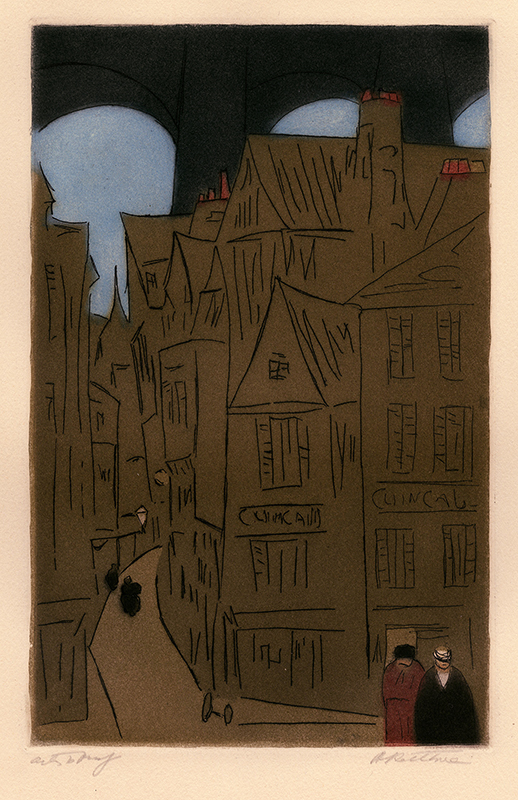Morlaix, Brittany is an etching and color aquatint created in 1936 by American artist, Augusta Rathbone (1897-1990). It is pencil signed and inscribed artist proof. Morlaix, Brittany was printed in Paris by Monsieur Porcabeuf on an unidentified cream wove paper and the platemark measures 9-3/4 x 6-1/4 inches.
Morlaix, also called Ville de Bretagne, is a commune located in Brittany in northwestern France that is nestled on the Dossen estuary enclosed by the foothills of the Monts de'Arrée mountains. The viaduct marks the boundary between the town’s sixteenth and seventeenth century heritage and its eighteenth century history. Built between the years 1861 and 1863, the viaduct has two levels with nine arches on the lower level and fourteen arches on the upper level. The port was once a hub of maritime trade, and is lined with buildings with imposing facades.
Augusta Payne Briggs Rathbone (1897-1990) was an American painter and printmaker. In 1921, upon graduating from the University of California at Berkeley, Augusta Rathbone continued her studies at the Académie de la Grande Chaumière in Paris. She also studied with Lucien Simon and for several years with the Spanish artist Claudio Castelucho y Diana. In 1927, at the suggestion of Nora Hamilton of Chicago, Rathbone began to concentrate on printmaking and took her plates to Monsieur Alfred Porcabeuf in Paris for printing. Her earliest intaglios featured the Sierra Nevada and urban scenes of New York and San Francisco. In the 1930s Rathbone created etching and aquatints of the villages in Brittany and the French Riviera. After World War II, she returned to Paris but in the face of prohibitive printing costs she taught herself how to print her plates.
Rathbone exhibited at the Salon de Nationale, Paris, in the spring of 1930 and 1931 and in the autumn salon of 1937. Her work was included in the exhibition American Color Prints at the Brooklyn Museum in 1933, and a solo exhibition of her work was mounted at the San Francisco Museum of Art in 1940. Her work and that of Elizabeth Ginno were featured at the California State Library in Sacramento in 1952 and again, in 1954, at the de Young Museum in San Francisco. Rathbone's artistic affiliations included memberships in the California Society of Etchers, San Francisco Women Artists, American Artists Professional League, and the National Arts Club.
In 1938, Rathbone joined forces with Juliet and Virginia Thompson to create the illustrated book, French Riviera Villages, published that year by Mitchell Kennerly. Twelve of Rathbone’s original color aquatints were reproduced, Juliet Thompson provided photography of the villages, and Virginia Thompson wrote a history on each village. The women joined forces to distribute their book after Kennerly failed to do so.
Augusta Rathbone's work is represented in the collections of the Brooklyn Museum, New York; the Bowdoin College Museum of Art, Brunswick, Maine; the Indianapolis Museum of Art, Indiana; the Zimmerli Art Museum, Rutgers University, New Brunswick, New Jersey; the Whitney Museum of American Art, New York; the Fine Arts Museums of San Francisco, California; the National Gallery of Art, Washington, D.C.; the Davis Museum at Wellesley College, Massachusetts; and the Worcester Art Museum, Massachusetts.



